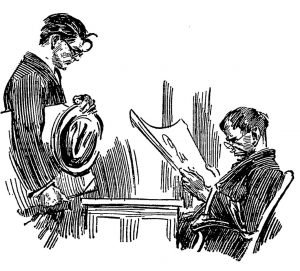How to Spot a Professional Cover Designer: Introduction & Industry Standards by Mary Neighbour
 Please welcome back guest author Mary Neighbor as she shares with us “How to Spot a Professional Cover Designer: Introduction & Industry Standards.” Enjoy!
Please welcome back guest author Mary Neighbor as she shares with us “How to Spot a Professional Cover Designer: Introduction & Industry Standards.” Enjoy!
***
Writers often hear, “Kill your darlings” (attributed to William Faulkner), meaning that you can’t afford to be too attached to your personal favorites—words, scenes, character traits—even whole characters. This advice is equally true when it comes to book cover design.
Choosing a Cover Design and a Cover Designer
Arguably the most difficult part for an author in choosing a cover design is to adopt an objective viewpoint. Your own sense of aesthetics may have (probably has) no place in the design of your book’s cover. Your personal photo of that gorgeous Bermuda sunset won’t mean much to the average book buyer. And the purpose of a good cover is to sell books. Period.
The professional cover artist’s aim, then, is to produce a design that helps your book sell, and he brings a specialized skill set to the job. Cover designers may address all or just one or two areas of design, so you may need to hire more than one professional to accomplish these various tasks:
- Developing an integrated design concept for front, back, and spine
- Adhering to standards and trends in your genre
- Choosing images, typeface, and colors
- Executing the design
- Working with the printer to achieve the desired results
(Note: the design of book interiors will be addressed separately in future blogs.)
Naturally, subjectivity eventually plays a role. The cover is artwork, and so the author will weigh the merits of one design over another. First, though, make sure the cover meets publishing industry standards and expectations.
Industry Standards for Cover Design
Another common maxim writers hear: you must have a professional cover design. But how can you know that it is? Even an award-winning graphical designer—with honors from the Royal College of Art—may not be the right choice to design your cover, if his award was for a body/mind/spirit book and you just wrote a time-travel thriller.
Fully understanding the industry standards, plus doing a little research on comparable books, will help you confidently choose a professional cover designer.
Tip: In addition to scanning covers on Amazon, consider any number of cover design awards, even ebook covers will provide insight.
On How to Spot a Professional Cover Designer
Standard #1: The cover fits within its genre
From the outset, consider the book consumer: consciously or unconsciously buyers have expectations about what a book should look like. They know a sci-fi book should not look like a memoir. Before you interview a designer, do online research within your genre so that you can see for yourself what buyers are buying.
If your nonfiction book is about business or money, the design should be straightforward, conveying reliability. If your fiction novel is suspenseful, bold type and colors will attract your readers.
Understanding the psychology of typography, color, and imagery are all part of the designer’s skill, and he will undertake to satisfy reader expectations. He will also endeavor to keep the design functional, so that it serves readability and comprehension. He, too, will kill his own darlings, never allowing the design to intrude upon the desired impact.
Standard #2: The cover suggests the type of reading experience
Even within a genre, two different book covers will broadcast different tones, reflecting the type of reading experience the writer intends; for example, humorous or ominous. Your online research will help you recognize the emotional tones of the stories in your genre. Consider aspects of harmony and contrast, as well, in making your determinations.
Standard #3: The cover provides basic information
The book title, obviously, needs to be on your cover, along with a subtitle, if applicable. The author’s name is also unfailingly placed on the front. Read on below to learn what other cover elements are traditionally included on the front, back, and spine of a book.
Standard #4: The design employs hierarchy
What is the primary focal point of the design? This will vary, book by book. It may be the author’s name, as is frequently seen with Stephen King books. For authors not of his stature, the focal point more likely will be an image or the combination of imagery, color, and typography, and the author name will not be as large or as prominent.
Hierarchy also implies the elimination of clutter and distracting elements. Designers often employ “the rule of thirds” (see next week’s blog) to create hierarchy and balance.
Tip: Not only does clutter distract the eye, but it doesn’t allow for the eventuality that your book may win an award, and you will want to display the award sticker in a manner that doesn’t obscure important aspects of the cover’s design.
Standard #5: The cover provokes interest and excitement
Duh! Like writing, cover design should include a hook, an inducement to the browser to seek more information about this book—and ultimately, to buy the book.
What Else Belongs on a Cover? (Hint: Your Cover Designer Would Know…)
There are conventions followed by professionals in the publishing industry. In terms of text, aside from the title, subtitle, and author name, very little should go on the front. Use this excellent rule of thumb to decide whether to add something to the front: If it’s famous or essential, it can stay:
- An award or prominent book club sticker
- A brief endorsement by a recognizable authority
- A discreet notice about a series or that supplemental material is included (usually for academic works)
Tip: No unsubstantiated claims are to be used. It’s not the “best ever” unless someone like the New York Times or Oprah is saying so.
If your front cover does its job, the browser will flip the book over to peruse the back. While no mandate exists that anything has to appear on the back, you want to continue to deepen the consumer experience. So, your cover artist also needs to design the back cover. These elements commonly are put to that task:
- Brief synopsis, hook, or blurb
- Endorsements and reviews
- Author bio and photo
- Book category or genre
- Price (sometimes in foreign denominations as well)
- Age range (seen mostly with children’s book)
- Bar code with ISBN
- Trademarks, URLs, or publishing logo
Bear in mind, though, that you don’t want the back cover to look dense; it, too, deserves a hierarchy. Be discerning in what you choose to include. Again, ask yourself if this element or that will lead the browser to purchase the book.
Finally, let’s not ignore the spine. Most retailers and libraries will display your book on a shelf, wedged between other books, with only the spine visible. What will make it stand out? Here again, a little research into your competition can help your designer create a spine that attracts attention. And he has to accomplish this with very few elements.
In addition to color, typography, and imagery (less commonly used on a spine), his design needs to legibly accommodate:
- Title (often without the subtitle)
- Author name (often just the last name)
- Publishing imprint or logo
Many trade books have only about a half-inch spine width, so you can see how challenging this gets.
Have you ever wondered how the width of the spine is calculated? Some cover designers will do this; others will expect the author or publisher to work with the printer to determine the width, and then they will adjust their design to that specification. Since you don’t want the spine “slipping” onto the front or the back covers, this width needs to be precise.
Tip: In these days of print-on-demand (POD), it is common that two spine widths are needed. For example, KDP Publishing and IngramSpark use different weights of paper, resulting in each company requiring a different spine width.
Before embarking on the design, have a discussion with your cover designer about the methods of printing and binding you intend to pursue.
Next week in this series: “Book Cover Design: Terminology.”
The following week: “Book Cover Design: Telltale Signs You’ve Hired a Professional.”
Mary’s previous posts are here.
***
ABOUT THE AUTHOR
 Some call Mary E. Neighbour a “book shepherd,” though Mary wields a blue pencil far more expertly than a herding rod. For the past ten years, she and her husband have helped dozens of writers bring their manuscripts to the marketplace, through MediaNeighbours, their publishing services business.
Some call Mary E. Neighbour a “book shepherd,” though Mary wields a blue pencil far more expertly than a herding rod. For the past ten years, she and her husband have helped dozens of writers bring their manuscripts to the marketplace, through MediaNeighbours, their publishing services business.
Passionate about helping authors make their work shine in the world, with a combined professional expertise of over 50 years in editing and design, this family team is one you’ll want to adopt as your guide through the challenging world of independent publishing.
Mary’s other passion is learning about the history of slavery and how it impacts race relations today. She incorporated much of her research into her novel, Speak Right On: Conjuring the Slave Narrative of Dred Scott









